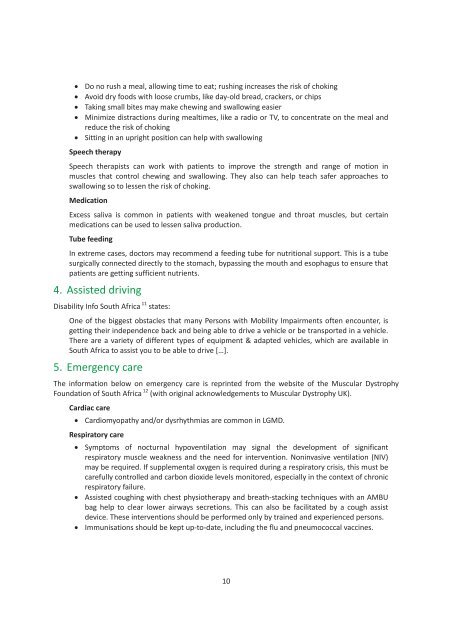Create successful ePaper yourself
Turn your PDF publications into a flip-book with our unique Google optimized e-Paper software.
Do no rush a meal, allowing time to eat; rushing increases the risk of choking<br />
Avoid dry foods with loose crumbs, like day-old bread, crackers, or chips<br />
Taking small bites may make chewing and swallowing easier<br />
Minimize distractions during mealtimes, like a radio or TV, to concentrate on the meal and<br />
reduce the risk of choking<br />
Sitting in an upright position can help with swallowing<br />
Speech therapy<br />
Speech therapists can work with patients to improve the strength and range of motion in<br />
muscles that control chewing and swallowing. They also can help teach safer approaches to<br />
swallowing so to lessen the risk of choking.<br />
Medication<br />
Excess saliva is common in patients with weakened tongue and throat muscles, but certain<br />
medications can be used to lessen saliva production.<br />
Tube feeding<br />
In extreme cases, doctors may recommend a feeding tube for nutritional support. This is a tube<br />
surgically connected directly to the stomach, bypassing the mouth and esophagus to ensure that<br />
patients are getting sufficient nutrients.<br />
4. Assisted driving<br />
Disability Info South Africa 11 states:<br />
One of the biggest obstacles that many Persons with Mobility Impairments often encounter, is<br />
getting their independence back and being able to drive a vehicle or be transported in a vehicle.<br />
There are a variety of different types of equipment & adapted vehicles, which are available in<br />
South Africa to assist you to be able to drive *…+.<br />
5. Emergency care<br />
The information below on emergency care is reprinted from the website of the Muscular Dystrophy<br />
Foundation of South Africa 12 (with original acknowledgements to Muscular Dystrophy UK).<br />
Cardiac care<br />
Cardiomyopathy and/or dysrhythmias are common in <strong>LGMD</strong>.<br />
Respiratory care<br />
Symptoms of nocturnal hypoventilation may signal the development of significant<br />
respiratory muscle weakness and the need for intervention. Noninvasive ventilation (NIV)<br />
may be required. If supplemental oxygen is required during a respiratory crisis, this must be<br />
carefully controlled and carbon dioxide levels monitored, especially in the context of chronic<br />
respiratory failure.<br />
Assisted coughing with chest physiotherapy and breath-stacking techniques with an AMBU<br />
bag help to clear lower airways secretions. This can also be facilitated by a cough assist<br />
device. These interventions should be performed only by trained and experienced persons.<br />
Immunisations should be kept up-to-date, including the flu and pneumococcal vaccines.<br />
10

















